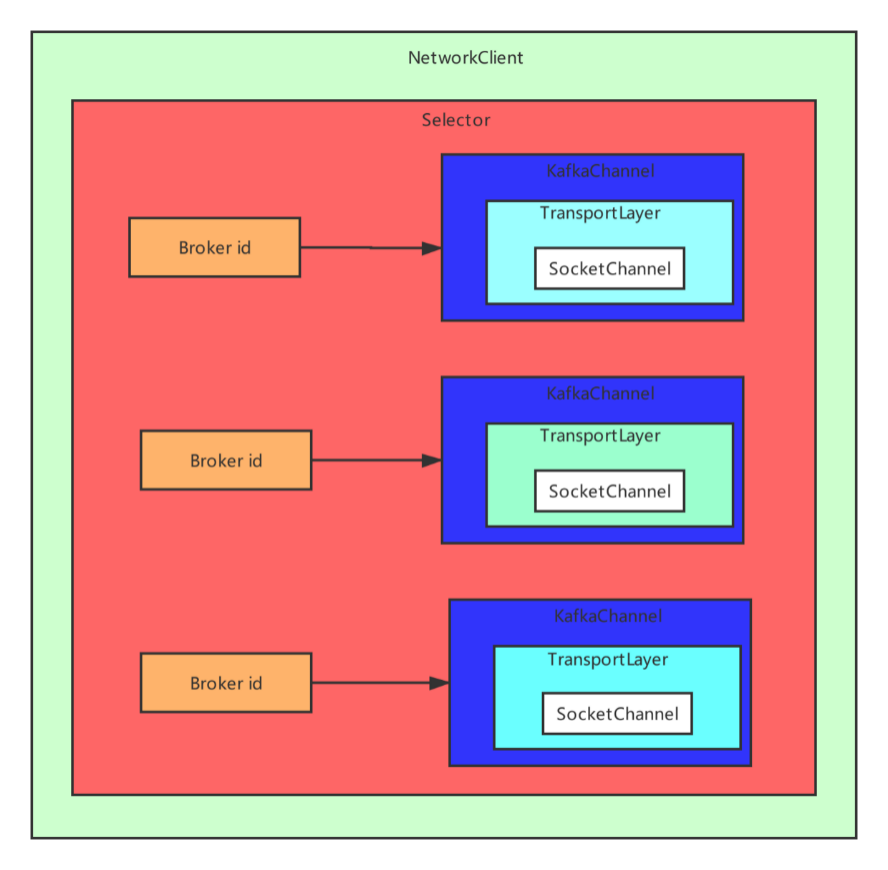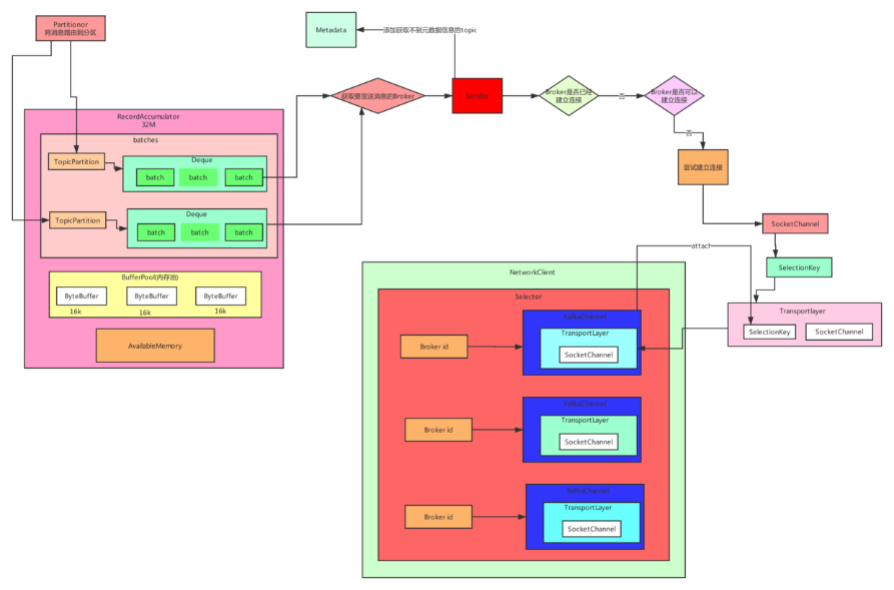
- 本次目标 -
之前我们在分析KafkaProducer获取元数据的时候就涉及到了网络的部分,不过那个时候我们没有去分析关于网络的事,现在KafkaProducer开始要与Broker建立连接,发送数据了,所以我们不得不分析一下Kafka网络部分代码的设计。(要想看懂这篇内容需要有Java NIO方面的知识,如果这方面知识有欠缺的话,需要自己单独去补一下)
- 源码剖析 -
我们接着上篇的内容继续分析: public boolean ready(Node node, long now) {//node没有信息if (node.isEmpty())throw new IllegalArgumentException("Cannot connect to empty node " + node);//TODO broker是否达到发送数据的条件if (isReady(node, now))//如果broker达到发送数据的条件了,直接返回truereturn true;//如果代码走到这儿就表示broker没有建立好连接,还不可以发送数据//所以这儿判断的是否可以与broker建立连接//如果判断的结果是true,那么就进去初始化连接//当然正常情况下判断结果都是true,所以我们这一节就重点分析//如何初始化连接if (connectionStates.canConnect(node.idString(), now))// if we are interested in sending to a node and we don't have a connection to it, initiate one//初始化连接
initiateConnect(node, now);return false;
}private void initiateConnect(Node node, long now) {
String nodeConnectionId = node.idString();try {log.debug("Initiating connection to node {} at {}:{}.", node.id(), node.host(), node.port());this.connectionStates.connecting(nodeConnectionId, now);//建立连接
selector.connect(nodeConnectionId,new InetSocketAddress(node.host(), node.port()),this.socketSendBuffer,this.socketReceiveBuffer);
} catch (IOException e) {/* attempt failed, we'll try again after the backoff */
connectionStates.disconnected(nodeConnectionId, now);/* maybe the problem is our metadata, update it */
metadataUpdater.requestUpdate();log.debug("Error connecting to node {} at {}:{}:", node.id(), node.host(), node.port(), e);
}
}private KafkaProducer(ProducerConfig config, Serializer keySerializer, Serializer valueSerializer) {
..............//NetworkClient是Kafka的核心的网络组建//底层核心的Selector负责最最核心的建立连接、发起请求、处理实际的网络IO
NetworkClient client = new NetworkClient(
new Selector(config.getLong(ProducerConfig.CONNECTIONS_MAX_IDLE_MS_CONFIG), this.metrics, time, "producer", channelBuilder),this.metadata,
clientId,
config.getInt(ProducerConfig.MAX_IN_FLIGHT_REQUESTS_PER_CONNECTION),
config.getLong(ProducerConfig.RECONNECT_BACKOFF_MS_CONFIG),
config.getInt(ProducerConfig.SEND_BUFFER_CONFIG),
config.getInt(ProducerConfig.RECEIVE_BUFFER_CONFIG),this.requestTimeoutMs, time);this.sender = new Sender(client,this.metadata,this.accumulator,
config.getInt(ProducerConfig.MAX_IN_FLIGHT_REQUESTS_PER_CONNECTION) == 1,
config.getInt(ProducerConfig.MAX_REQUEST_SIZE_CONFIG),
(short) parseAcks(config.getString(ProducerConfig.ACKS_CONFIG)),
config.getInt(ProducerConfig.RETRIES_CONFIG),this.metrics,
new SystemTime(),
clientId,this.requestTimeoutMs);
.........
}public class Selector implements Selectable {public static final long NO_IDLE_TIMEOUT_MS = -1;private static final Logger log = LoggerFactory.getLogger(Selector.class);//我们神奇的发现这个Selector 的nioSelector就是java nio里面的selector//也就是说Kafka的Selector就是对java nio的selector进行了封装//用户监听网络的I/O事件private final java.nio.channels.Selector nioSelector;//这里保存了每个broker id到Channel的映射关系,对于每个broker都有// 一个网络连接,每个连接在NIO的语义里,都有一个对应的SocketChannel,//KafkaChannel其实就是封装了SocketChannel,我们后面再去分析这个KafkaChannelprivate final Map channels;//已经成功发送出去的请求private final List completedSends;//已经接收回来的响应而且被处理完了private final List completedReceives;//每个Broker的收到的但是还没有被处理的响应private final Map> stagedReceives;//指的就是private final Set immediatelyConnectedKeys;//没有成功建立连接private final List disconnected;//成功建立连接private final List connected;//发送请求失败的brokerprivate final List failedSends;private final Time time;private final SelectorMetrics sensors;private final String metricGrpPrefix;private final Map metricTags;private final ChannelBuilder channelBuilder;private final int maxReceiveSize;private final boolean metricsPerConnection;private final IdleExpiryManager idleExpiryManager;/**
* Create a new nioSelector
*
* @param maxReceiveSize Max size in bytes of a single network receive (use {@link NetworkReceive#UNLIMITED} for no limit)
* @param connectionMaxIdleMs Max idle connection time (use {@link #NO_IDLE_TIMEOUT_MS} to disable idle timeout)
* @param metrics Registry for Selector metrics
* @param time Time implementation
* @param metricGrpPrefix Prefix for the group of metrics registered by Selector
* @param metricTags Additional tags to add to metrics registered by Selector
* @param metricsPerConnection Whether or not to enable per-connection metrics
* @param channelBuilder Channel builder for every new connection
*/public Selector(int maxReceiveSize,long connectionMaxIdleMs,
Metrics metrics,
Time time,
String metricGrpPrefix,
Map metricTags,boolean metricsPerConnection,
ChannelBuilder channelBuilder) {try {this.nioSelector = java.nio.channels.Selector.open();
} catch (IOException e) {throw new KafkaException(e);
}this.maxReceiveSize = maxReceiveSize;this.time = time;this.metricGrpPrefix = metricGrpPrefix;this.metricTags = metricTags;this.channels = new HashMap<>();this.completedSends = new ArrayList<>();this.completedReceives = new ArrayList<>();this.stagedReceives = new HashMap<>();this.immediatelyConnectedKeys = new HashSet<>();this.connected = new ArrayList<>();this.disconnected = new ArrayList<>();this.failedSends = new ArrayList<>();this.sensors = new SelectorMetrics(metrics);this.channelBuilder = channelBuilder;this.metricsPerConnection = metricsPerConnection;this.idleExpiryManager = connectionMaxIdleMs 0 ? null : new IdleExpiryManager(time, connectionMaxIdleMs);
}public class KafkaChannel {//broker id对应一个网络连接,一个网络连接对应一个KafkaChannel,// 底层对应的是SocketChannel,SocketChannel对应的是最最底层的网络通信层面的一个Socket,private final String id;//TODO 重要//我们之前猜想 KafkaChanel就是对原生的java nio封装了一下//但是我们进入到KafkaChannel的代码中发现,其实//没有发现SocketChannel的字眼,其实TransportLayer//又对KafkaChannel封装了一次private final TransportLayer transportLayer;private final Authenticator authenticator;private final int maxReceiveSize;//最近一次读出来的响应,先暂存在这里,这个值是会不断的变换的,因为会不断的读取新的响应数据private NetworkReceive receive;//发送出去的请求,这个值会不断发生变化,因为发送完一个请求需要发送下一个请求private Send send;public KafkaChannel(String id, TransportLayer transportLayer, Authenticator authenticator, int maxReceiveSize) throws IOException {this.id = id;this.transportLayer = transportLayer;this.authenticator = authenticator;this.maxReceiveSize = maxReceiveSize;
}
} public interface TransportLayer extends ScatteringByteChannel, GatheringByteChannel {/**
* Returns true if the channel has handshake and authentication done.
*/boolean ready();/**
* Finishes the process of connecting a socket channel.
*/boolean finishConnect() throws IOException;/**
* disconnect socketChannel
*/void disconnect();/**
* Tells whether or not this channel's network socket is connected.
*/boolean isConnected();/**
* returns underlying socketChannel
* TODO 这个就是java里面的SocketChannel
*/SocketChannel socketChannel();/**
* Performs SSL handshake hence is a no-op for the non-secure
* implementation
* @throws IOException
*/void handshake() throws IOException;/**
* Returns true if there are any pending writes
*/boolean hasPendingWrites();/**
* Returns `SSLSession.getPeerPrincipal()` if this is a SslTransportLayer and there is an authenticated peer,
* `KafkaPrincipal.ANONYMOUS` is returned otherwise.
*/Principal peerPrincipal() throws IOException;void addInterestOps(int ops);void removeInterestOps(int ops);boolean isMute();/**
* Transfers bytes from `fileChannel` to this `TransportLayer`.
*
* This method will delegate to {@link FileChannel#transferTo(long, long, java.nio.channels.WritableByteChannel)},
* but it will unwrap the destination channel, if possible, in order to benefit from zero copy. This is required
* because the fast path of `transferTo` is only executed if the destination buffer inherits from an internal JDK
* class.
*
* @param fileChannel The source channel
* @param position The position within the file at which the transfer is to begin; must be non-negative
* @param count The maximum number of bytes to be transferred; must be non-negative
* @return The number of bytes, possibly zero, that were actually transferred
* @see FileChannel#transferTo(long, long, java.nio.channels.WritableByteChannel)
*/long transferFrom(FileChannel fileChannel, long position, long count) throws IOException;
} 我们理解了上面的内容后,我们继续分析一开始看到的代码:
我们理解了上面的内容后,我们继续分析一开始看到的代码:
private void initiateConnect(Node node, long now) {
String nodeConnectionId = node.idString();try {log.debug("Initiating connection to node {} at {}:{}.", node.id(), node.host(), node.port());this.connectionStates.connecting(nodeConnectionId, now);//建立连接
selector.connect(nodeConnectionId,new InetSocketAddress(node.host(), node.port()),this.socketSendBuffer,this.socketReceiveBuffer);
} catch (IOException e) {/* attempt failed, we'll try again after the backoff */
connectionStates.disconnected(nodeConnectionId, now);/* maybe the problem is our metadata, update it */
metadataUpdater.requestUpdate();log.debug("Error connecting to node {} at {}:{}:", node.id(), node.host(), node.port(), e);
}
}public void connect(String id, InetSocketAddress address, int sendBufferSize, int receiveBufferSize) throws IOException {if (this.channels.containsKey(id))throw new IllegalStateException("There is already a connection for id " + id);//TODO 获取Socketchannel
SocketChannel socketChannel = SocketChannel.open();//设置为非阻塞
socketChannel.configureBlocking(false);//
Socket socket = socketChannel.socket();
socket.setKeepAlive(true);if (sendBufferSize != Selectable.USE_DEFAULT_BUFFER_SIZE)
socket.setSendBufferSize(sendBufferSize);if (receiveBufferSize != Selectable.USE_DEFAULT_BUFFER_SIZE)
socket.setReceiveBufferSize(receiveBufferSize);//TcpNoDelay,如果默认是设置为false的话,那么就开启Nagle算法,// 就是把网络通信中的一些小的数据包给收集起来,// 组装成一个大的数据包然后再一次性的发送出去,如果大量的小包在传递,会导致网络拥塞
socket.setTcpNoDelay(true);
boolean connected;try {/**
* 如果此通道处于非阻塞模式,则调用
* 方法启动非阻塞连接操作。如果连接
* 立即建立,就像本地连接一样,然后
* 此方法返回true,否则,此方法返回
* false连接操作稍后必须由
* 调用@link finishConnect finishConnect方法。
*///TODO 尝试去连接
connected = socketChannel.connect(address);
} catch (UnresolvedAddressException e) {
socketChannel.close();throw new IOException("Can't resolve address: " + address, e);
} catch (IOException e) {
socketChannel.close();throw e;
}//TODO 向Selector注册OP_CONNECT事件
SelectionKey key = socketChannel.register(nioSelector, SelectionKey.OP_CONNECT);//TODO 封装KafkaChannel
KafkaChannel channel = channelBuilder.buildChannel(id, key, maxReceiveSize);//关联
key.attach(channel);this.channels.put(id, channel);//已经建立了连接if (connected) {// OP_CONNECT won't trigger for immediately connected channelslog.debug("Immediately connected to node {}", channel.id());
immediatelyConnectedKeys.add(key);
key.interestOps(0);
}
}

- 总结 -
这一小节的内容有些复杂,大家跟着源码多理解几次,如果本小节的代码流程如果梳理不清楚的话,会影响到整个Kafka流程的学习,因为整个Kafka组件之间的网络通信就是用我们这讲的内容搭建的。这一小节我们分析了KafkaProducer的网络结构,尝试与Broker建立连接,但是还没正式建立上连接,下一次我们分析一下,KafkaProducer还没与Broker正式建立起连接,那么它会向Broker发送消息吗? 大家加油!! - 关注“大数据观止” -
- 关注“大数据观止” -





















 331
331











 被折叠的 条评论
为什么被折叠?
被折叠的 条评论
为什么被折叠?








